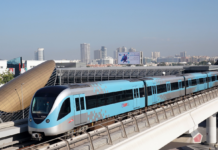By Adam Gonn www.gulf-times.com
If you look out the carriage window to your right, this train will be passing the majestic Arabian desert and to your left the water of the Gulf.

It could be true by 2017 when the new proposed regional rail network is scheduled to connect all six countries that make up the Gulf Co-operation Council (GCC) – Kuwait, Qatar, Bahrain, Saudi Arabia, Oman and the United Arab Emirates (UAE).
When the idea was first presented the estimated cost was $14bn but that sum has since risen to $25bn due to changing technical specifications, an issue at the heart of negotiations among regional heads.
“I think this in an interesting concept but it needs a central structure that will follow up on the development and work on finding solutions,” Jean-Pierre Loubinoux, general director of the International Union of Railways, told The Media Line.
Its economic feasibility, on the other hand, was something that still needed to be evaluated, he said.
One of the main sources of inspirations for the network is the Dubai Metro, inaugurated on September 9. Despite the fact that not all the lines have been completed yet, the metro or light railway, is being used by thousands of residents, and being considered a huge success. The trains, which are fully automated and driverless, are expected to carry 1.2mn passengers a day upon completion.
The rail project is just one of a number of projects that the six countries are working on to increase their co-operation.
“There is an apparent will to come towards more economic integration and this would be translated by actual infrastructural common work, of which the rail network is one example,” Philippe Dauba-Pantanacce, senior economist with Standard Chartered Bank in Dubai told The Media Line.
“There are still a lot of questions pertaining to the actual need of such a network. It’s a great idea in terms of concept but at the same time we know from history that rail networks function best in high-density areas. Something which is not the case here in the region,” he said.
“We see some signs of converging economic activity and one of the best examples is the electricity grid which was connected over the summer,” he said.
Despite Saudi Arabia having the world’s largest known oil reserves as well as being the number one oil producer in the world, and despite both Qatar and Bahrain being home to vast natural gas resources, electricity is still a scarce commodity. As a shared problem, electricity production serves well as a point of co-operation.
According to some estimations, the need for electricity is expected to increase between 5% to 7% annually.
In order to deal with this problem the nations completed the first stage in June 2009 of what will become a regional power grid. The grid, which is due for completion in 2015, is expected to cost $49bn.
Another sign of increasing co-operation can be seen in the plans for a common currency and a de-pegging from the dollar.
While the Gulf countries experienced tremendous economic growth and development following the discovery of oil in the region in the 1950s, their currencies have remained insignificant in the international market.
In addition to the Gulf’s currencies being pegged to the US dollar, oil is traded in it, which has forced the regional central banks to keep their currencies on a par with the dollar. This has meant that their currency has been limited by the strength of the American economy rather than their own.
While plans for de-pegging are strong in Saudi Arabia, Qatar and Kuwait, support for it across the whole region is only partial, with the UAE having pulled out in May 2009 and Oman back in 2004.
Another joint infrastructural project is the Dolphin gas pipeline, which starts in Qatar and goes to Oman via the UAE. Because natural gas is considered to represent a diversification of the national economies away from oil, the pipeline is seen as a crucial development.
“Another major topic that I would say is very important is the better integration of statistical tools, this is crucial if you are thinking about more economic integration,” Dauba-Pantanacce said.
“If one day you want to move towards a homogenous market it is imperative to have comparative statistical tools. The latest one to have been announced was one on inflation,” he concluded.



















